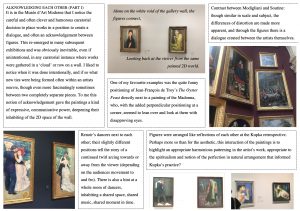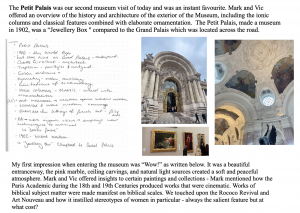With the advance of generative AI and its integration into both the classroom and assessments, teachers are exploring approaches evaluate students’ authentic learning. Here, we highlight the benefits of a meta-cognitive assessment task, specifically the reflective journal, as an authentic assessment applied in the discipline of Art History within the context of the fieldwork unit ARHT3681: Art and the City.
Unit overview and the reflective journal as key component
ARHT3681 was developed with the support of an education innovation grant secured in 2018 aiming to integrate object-based and student-centred learning into the Art History curriculum. Offered during the summer or winter intensive periods, this unit has taken small cohorts of students (averaging at 25 students) out of the classroom and to Paris (in its 2017, 2018 and 2024 iterations) and Berlin (2019 and 2023 iterations) to explore not only the history of architecture and public space but also the galleries, collections and artworks housed in these cities. Such experiences provide a vital opportunity for students to learn with and from artworks, buildings, spaces, and monuments in situ, allowing them to engage deeply with their subject matter in a real-world context. The assessment components include in-situ group presentations, individual multimedia presentations (in various formats submitted before or after fieldwork), and, more importantly, a reflective journal, which constitutes a key part of the unit.
Meta-cognition: the benefits of reflection
Given the immersive and experiential on-site learning that ARHT3681 offers, it was essential to align the main assessment task with the nature of learning beyond the traditional classroom or lecture/tutorial format. The reflective journal was selected as an appropriate summative assessment. Since pioneering studies in the 1980s (Boud, Keogh and Walker, 1985) literature on the practice of reflective writing for assessment has first argued for, then demonstrated the importance of meta-cognitive tasks for development of key skills and creation of positive outcomes in Nursing, Medicine, ELT and IT among other disciplines and areas (O’Loughlin and Griffith, 2020; Alabidi et al., 2022). Many institutions and disciplines across Australia and internationally have now generalised the practice of asking students to maintain a regular reflective journal in which they document and critically analyse their personal (and even collective) learning (see for example the guides of Cambridge University and UNSW).
The assessments themselves were much more interesting, challenging and frankly, more useful for learning purposes than any of the assignments I have completed in my entire degree
In the context of this unit, the reflective journal allows students to demonstrate their personal and critical engagement with fieldwork and their comprehensive understanding of the history, artworks and cultural sites visited. During the fieldwork period, students are required to regularly journal the visits, reflecting on the spontaneous notes taken at each site based on their impressions, observations, and discussions on museology, architecture, and artworks for instance. After the trip, they must organise their notes and submit their journal, often rewriting some of their entries with the benefit of further reflection on their experiences and learning, linking insights from different places. As one student noted in the Unit of Study Survey: “My level of analysis and thinking improved so dramatically over the two weeks that by the end I had to rewrite my journal entries from the first few days as they were not up to the standard I had evolved to.” Students are also expected to provide a portion of raw notes, including in-situ written observations, personal sketches, photographs, or cutouts from leaflets collected on-site, to serve as visual evidence supporting their reflections. This combination of words and images aims to provide a deep and consistent critical inquiry. One student wrote in the 2018 survey: “The assessments themselves were much more interesting, challenging and frankly, more useful for learning purposes than any of the assignments I have completed in my entire degree – they forced us to think independently in a manner that I hadn’t been tested before.”
What makes a ‘good’ reflective journal?
Assessing reflective journals requires to clearly outline expectations to students depending on the disciplines and definitions of what makes ‘good’ reflective writing (King’s College London offers useful resources in this area).
Key expectations for the ARHT3681 reflective journal included, besides comprehensive documentation of all visits and coherent structure, evidence of consistent student engagement in on-site activities and discussions. The primary aim of the journal is to demonstrate the student’s in-depth critical engagement, with reflections rooted in their experiences of the sites and encounters with artworks or monuments. Students are expected to do so in a personalised manner, while applying their critical skills as art historians to analyse the material, cultural, and social meanings of the sites or artworks.


In the January-February 2024 iteration of the unit, we specifically addressed the question of how we could ensure the diversity and authenticity of the reflective journal as an assessment. When assessing the journals, we encouraged pen and paper notetaking, looked for signs of authenticity in the reflections, indicating that the observations could only be made by visiting the site or seeing the artwork in person within its museological and physical context. The rigour of the journal as an assessment was further reinforced thanks to the visual evidence, such as annotated photographs or sketches, that students used to support their critical and experiential comments and arguments, also highlight their learning process throughout the course.


While each entry may not provide scope for students to flesh out their reflection, all should provide a critical point of view on their experience and what they learnt and some should mark a deeper level of intellectual reflection. Effective reflective journals address ‘big’ questions regarding art historical and curatorial issues, and the nature of museums for instance. These reflections often stemmed from group discussions that occurred on site, whether led by the course teachers or other students, or from the student’s personal knowledge and independent thinking, which were augmented with research.
The reflective journal and Universal Design for Learning (UDL)
The reflective journal aligns with UDL principles by offering multiple forms of engagement as an assessment task. Through its personalised dimension, the journal invites students to reflect on their own interests, experiences, and ways of learning, highlighting what is most relevant, valuable, and meaningful to them. It also allows for a flexible format that accommodates various modes of demonstrating the acquisition of knowledge and skills. Students may choose to structure their journal in chronological order, following the schedule of the fieldwork course, or opt for a different format, provided they can justify their decision. For example, in 2024, a student created their journal in a mind map format, designed to make sense regardless of the entry point. This flexibility ensures that all submitted journals are inclusive, personalised and unique to each student’s interests and learning modes.
While we are convinced that reflective journals have a very important place in assessing experiential and in-situ learning, we also believe that reflective practice and its assessment has a place across the curriculum. This is particularly relevant in the light of the challenges that we face as teachers working with generative AI and the principles of UDL. We remain keen to explore how current research and our own experience can inform the creation of guidelines and rubrics that will ensure the successful implementation of such assessments across a variety of course units.





